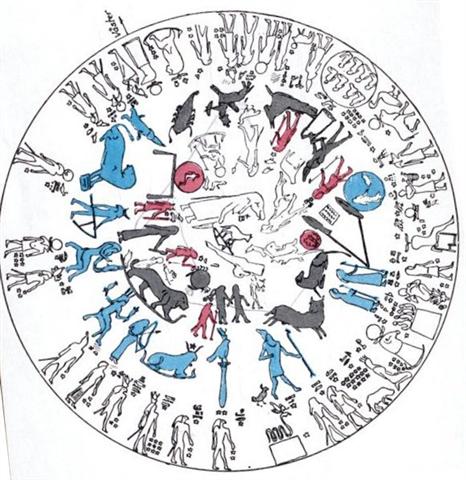179. In the Dendera round
zodiac Kjellson (Henry Kjellson,
Forntidens teknik) carefully measured
the distance from our own well known 12 zodiacal
figures (painted grey in his illustration
below) to
a sequence of 11 unfamiliar bluemarked ones and found
the result to be 21º as regards the position
of the north pole:
But 21º is outside the range of the
obliquity:
(22º 36' 41" + 24º 14' 07") / 2 = [(22 * 60
* 60 + 36 * 60 + 41)" + (24 * 60 * 60 + 14 *
60 + 7)"] / 2 = (81401 + 87247)" / 2 =
84324" = 23º 25' 24".
Therefore the bluepainted figures were probably
arranged in timespace and not in spacetime. We can guess
21º represented 21 right ascension days, or
rather - because zeroes were insignificant -
210 days.
|

... The sitting figures in two rows
at the top are the 42 Judges
(Assessors) of the Dead.
... The four
bereaved and searching divinities,
the two mothers and their two sons,
were joined by a fifth, the moon-god
Thoth (who appears sometimes in the
form of an ibis-headed scribe, at
other times in the form of a
baboon), and together they found all
of Osiris save his genital member,
which had been swallowed by a fish.
They tightly swathed the broken body
in linen bandages, and when they
performed over it the rites that
thereafter were to be continued in
Egypt in the ceremonial burial of
kings, Isis fanned the corpse with
her wings and Osiris revived, to
become the ruler of the dead. He
now sits majestically in the
underworld, in the Hall of the Two
Truths, assisted by forty-two
assessors, one from each of the
principal districts of Egypt; and
there he judges the souls of the
dead. These confess before him, and
when their hearts have been weighed
in a balance against a feather,
receive, according to their lives,
the reward of virtue and the
punishment of sin ... |
210 (blue days) + 366 (grey days) = 576 = 3
* 192 = 12 * 48 = 12 (29 + 19) = 348 (glyphs
on side b of the C tablet) + 228 = 584
(cycle of Venus) - 8.
403 (= 13 * 31) - 210 (= 7 * 30) = 193 (July 12)
where Castor - the Beaver who built his
house down in the water - rose with the Sun,
and this was 25 days after Betelgeuze, the
Moist One:

 |
 |
 |
 |
 |
|
Ga1-22 |
Ga1-23 → 403 - 280 |
Ga1-24 → 48 |
Ga1-25 → 5 * 5 * 5 |
Ga1-26 |
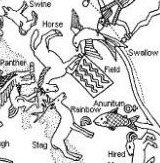 |
|
μ Columbae,
SAIPH
(Sword) = κ Orionis
(86.5), τ Aurigae, ζ Leporis
(86.6) |
υ Aurigae (87.1), ν Aurigae
(87.2),
WEZN
(Weight) = β Columbae,
δ Leporis (87.7),
TZE (Son) = λ Columbae
(87.9) |
Ardra-6 (The Moist One) /
ANA-VARU-8 (Pillar to sit
by)
χ¹ Orionis, ξ Aurigae (88.1),
BETELGEUZE
= Α Orionis (88.3),
ξ Columbae (88.5), σ Columbae
(88.7)
ZUBEN ELGENUBI (α Librae)
|
η Leporis (89.0),
PRAJA-PĀTI
= Δ Aurigae, MENKALINAN = Β
Aurigae, MAHASHIM = Θ Aurigae,
and Γ Columbae (89.3),
π Aurigae (89.4), η Columbae
(89.7) |
μ
Orionis (90.3),
χ² Orionis (90.5) |
|
June 15 |
16 |
17 (168) |
18 |
19 |
|
°June 11 |
12 |
13 (164) |
14 |
15 (*86) |
|
'May 19 |
20 |
21 (141) |
22 |
23 (*63) |
|
"May 5 |
6 |
7 (127) |
8 |
9 (*49) |
|
APRIL 12 |
13 |
14 (104) |
15 |
16 (*26) |
|
82 |
83 |
84 (= 12 * 7) |
85 (= 5 * 17) |
86 |
 |
|
17 |
 |
 |
 |
 |
 |
|
Ga2-13 |
Ga2-14 |
Ga2-15 (45) |
Ga2-16 |
Ga2-17 |
|
WEZEN
(Weight) = δ Canis Majoris
(107.1), τ Gemini (107.7), δ
Monocerotis (107.9) |
no star listed (108) |
λ Gemini (109.4),
WASAT
(Middle) = δ Gemini
(109.8) |
no star listed (110) |
ALUDRA
(Virgin) = η Canis Majoris
(111.1),
PROPUS = ι Gemini
(111.4),
GOMEISA
(Water-eyed) = β Canis Minoris
(111.6) |
|
July 6 (*107) |
7 (188) |
8 |
9 |
10 |
|
°July 2 |
3 (184) |
4 |
5 |
6 (*107) |
|
MAY 3 (123) |
4 |
5-5 (*45) |
6 |
7 (127) |
|
103 |
104 |
105 (= 365 - 260) |
106 |
107 |
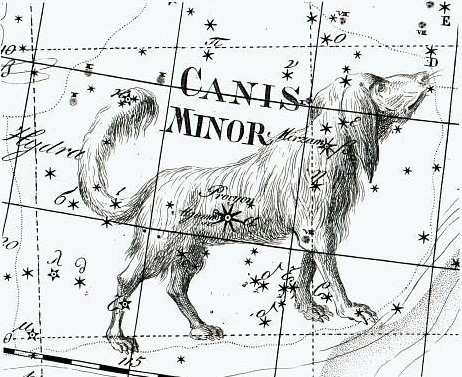 |
 |
 |
 |
 |
 |
 |
|
Ga2-18 |
Ga2-19 |
Ga2-20 (50) |
Ga2-21 |
Ga2-22 |
Ga2-23 |
|
Ghost-23
(Goat)
ρ Gemini (?) (112.1),
Eskimo Nebula = NGC2392
Gemini
(112.2)
ANTARES (α Scorpii)
|
Al Dhirā'-5 (Forearm) /
Punarvasu-7 (Doublegood
Pair) /
Mash-mashu-Mahrū-10
(Western One of the Twins)
CASTOR
= α Gemini
(113.4) |
ANA-TAHUA-VAHINE-O-TOA-TE-MANAVA-7
(Pillar for elocution)
υ Gemini (114.0),
MARKAB PUPPIS = κ Puppis
(114.7), ο Gemini (114.8),
PROCYON
= α Canis Minoris
(114.9) |
α
Monocerotis
(115.4), σ Gemini (115.7) |
Mash-mashu-arkū-11
(Eastern One of the Twins)
κ Gemini (116.1),
POLLUX
= β Gemini
(116.2), π Gemini (116.9) |
AZMIDISKE = ξ Puppis
(117.4) |
|
GEMINI: |
|
7 |
Punarvasu |
α and β Gemini |
Bow and quiver |
113 = 88
+ 25
|
|
the two restorers of
goods |
Castor and Pollux |
July 12 (193) |
... In Hindu legend there
was a mother goddess called
Aditi, who had seven
offspring. She is called
'Mother of the Gods'. Aditi, whose name
means 'free, unbounded,
infinity' was assigned in
the ancient lists of
constellations as the regent
of the asterism Punarvasu.
Punarvasu is dual in
form and means 'The
Doublegood Pair'. The
singular form of this noun
is used to refer to the star
Pollux. It is not difficult
to surmise that the other
member of the Doublegood
Pair was Castor. Then the
constellation Punarvasu
is quite equivalent to our
Gemini, the Twins. In far
antiquity (5800 B.C.) the
spring equinoctial point was
predicted by the heliacal
rising of the Twins ... By
4700 B.C. the equinox lay
squarely in Gemini
(fig. 6.7).
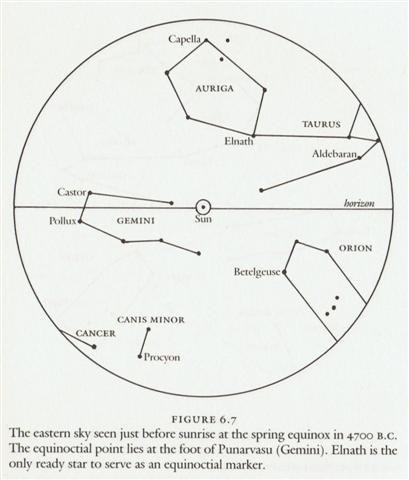
4700 BC + 1842
AD = 6542 = 92.14 *
71. |
|
July 11 (192) |
12 |
13 (*114) |
14 |
15 |
16 |
|
°July 7 |
8 |
9 |
10 |
11 (*112) |
12 (193) |
|
MAY 8 |
9 |
10 (130) |
11 |
12 |
13 (*53) |
|
108 |
109 |
110 |
111 |
112 |
113 |
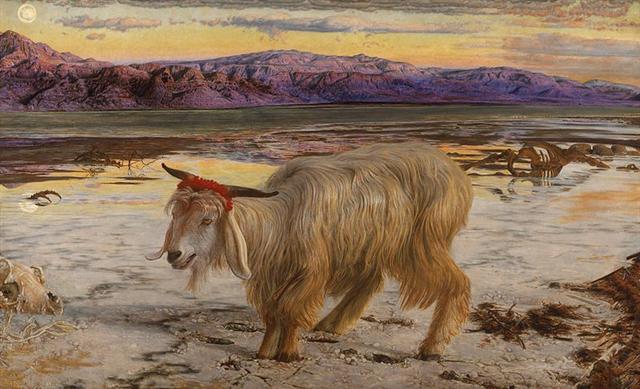
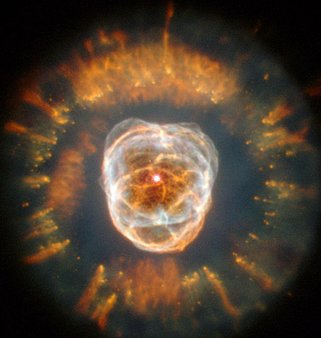 |
We can guess Pollux
stood for the bow while Castor
represented the
quiver. Pollux was in the east and
Castor in the west, which suggests
time went withershins, like the
Moon. Or like when the Sun
returned through the Underworld from
the horizon in the west to be reborn
again at the horizon in the east.
The bluemarked woman
archer of Kjellson has the Sothis
cow (Sirius) in front:
... The Sothic cycle
was based on what is referred to in
technical jargon as 'the periodic
return of the heliacal rising of
Sirius', which is the first
appearance of this star after a
seasonal absence, rising at dawn
just ahead of the sun in the eastern
portion of the sky. In the case of
Sirius the
interval between one such rising and
the next amounts to exactly 365.25
days - a mathematically harmonious
figure, uncomplicated by further
decimal points, which is just twelve
minutes longer than the duration of
the solar year
...
And beyond was
a pillar like an arrow with a
perching bird at the top - which
could have
indicated the tail feathers of the
arrow, implying the arrow head had
hit its target.
|
...
12. Odysseu's arrival
home: Transformed by
Athene into the semblance of
a beggar (Noman, still), the
returned master of the house
was recognized only by his
dog and his old, old nurse.
The latter spied above his
knee the old scar of a gash
received from the tusk of a
boar. (Compare Adonis and
the boar, Attis and the
boar, and, in Ireland,
Diarmuid and the boar.)
Hushing the nurse, Odysseus
watched for some time the
shameless behavior of the
suitors and maidservants in
his house; whereafter, and
at last:
13. Penelope, offering to
marry any one of those
present who could draw the
powerful bow of her spouse,
set up a target of twelve
axes to be pierced. None
of the suitors could even
string the bow. Several
tried manfully. The recently
come beggar then offered and
was mocked. However, as we
read:
He already was handling the
bow, turning it every way
about, and proving it on
this side and that, lest the
worms might have eaten the
horns when the lord of the
bow was away...
And Odysseus of many
counsels had lifted the
great bow and viewed it on
every side, and even as when
a man that is skilled in the
lyre and in minstralsy,
easily stretches a cordabout
a new peg, after tying at
either end the twisted
sheep-gut, even so Odysseus
straightway bent the great
bow, all without effort, and
took it in his right hand
and proved the bowstring,
which rang sweetly at the
touch, in tone like a
swallow.
Then great grief came upon
the wooers, and the color of
their countenance was
changed, and Zeus thundered
loud showing forth his
tokens. And the steadfast
goodly Odysseus was glad
thereat, in that the son of
deep-counselling Cronus had
sent him a sign.
Then he caught up a swift
arrow which lay by his
table, bare, but the other
shafts were stored within
the hollow quiver, those
whereof the Achaeans were
soon to taste.
He took and laid it on the
bridge of the bow, and held
the notch and drew the
string, even from the settle
whereupon he sat, and with
straight aim shot the shaft
and missed not one of the
axes, beginning from the
first ax-handle, and the
bronze-weighted shaft passed
clean through and out at the
last.
The solar hero having thus
demonstrated his passage of
the twelve signs and his
lordship of the palace, he
proceeded masterfully to the
shooting down of the
suitors. 'And they writhed
with their feet for a little
space, but for no long
while.'
After which, 'Thy bed verily
shall be ready,' said the
wisely wifely Penelope.
'Come tell me of thine
ordeal. For methinks the day
will come when I must learn
it, and timely knowledge is
no hurt'
... |
Above were the Great
Twins (the Doublegood Pair):
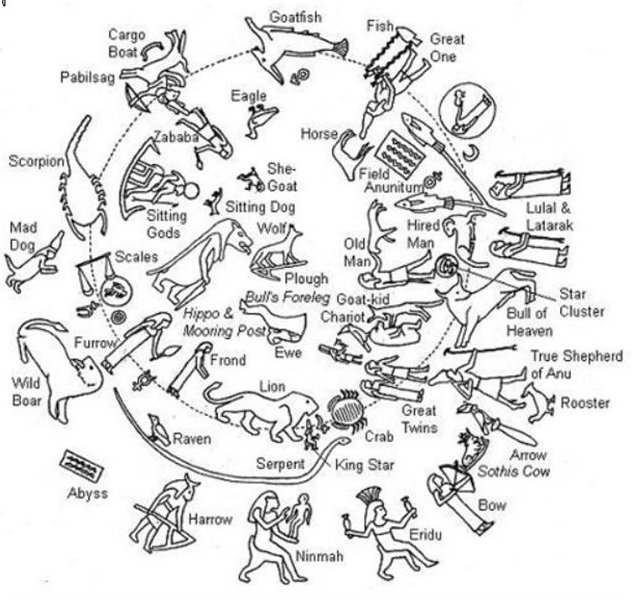
The corresponding
view of the Mayas was illustrated
with one of the Twins (with the
spots of a single Jaguar) shooting down
the bird at the top of the Tree:

... This pot depicts one of the Hero
Twins (One-Ahaw in the Classic texts
and One-Hunaphu in the K'iche' Popol
Vuh) and a great bird who is trying
to land in a huge ceiba tree heavy
with fruit. This mythical bird is
Itzam-Yeh, Classic prototype of
Wuqub-Kaqix, 'Seven-Macaw',
of Popol Vuh fame. In that story, in
the time before the sky was lifted
up to make room for the light, the
vainglorious Seven-Macaw [Ursa
Major] imagined himself to be the
sun. Offended by his pride, the Hero
Twins humbled him by breaking his
beautiful shining tooth with a
pellet from their blowgun. This pot
shows One-Ahaw aiming at the bird as
he swoops down to land in his tree.
As Itzam-Yeh lands on his
perch, the text tells us he is
'entering or becoming the sky'.
This particular 'sky-entering' is
not the one mentioned in the
Palenque text. It is the final event
that occurred in the previous
creation before the universe was
remade. Before the sky could be
raised and the real sun revealed in
all its splendor, the Hero Twins had
to put the false sun, Itzam-Yeh,
in his place. If the date on this
pot corresponds to that
pre-Columbian event, as we believe
it does, then Itzam-Yeh was
defeated on 12.18.4.5.0.1 Ahaw
3 K'ank'in (May 28, 3149
B.C.). After the new universe was
finally brought into existence,
First Father also entered the sky by
landing in the tree, just as
Itzam-Yeh did
...
Ursa Major was at the
North Pole before the precession had
moved the point of the arrow of time
(vero) to Ursa
Minor.
... Another name for the Goddess of
the Mill was Artemis Calliste, or
Callisto ('Most Beautiful'), to whom
the she-bear was sacred in Arcadia;
and in Athens at the festival of
Artemis Brauronia, a girl of ten
years old and a girl of five,
dressed in saffron-yellow robes in
honour of the moon, played the part
of sacred bears. The Great She-bear
and Little She-bear are still the
names of the two constellations that
turn the mill around. In Greek the
Great Bear Callisto was also called
Helice, which means both
'that which turns' and
'willow-branch' - a reminder that
the willow was sacred to the same
Goddess ...

...
I became curious about this star ...
called Nuutuittuq [= 'never
moves'] ... So, on the lee side of
our uquutaq (a snow
windbreak) I positioned a harpoon
pointing directly at this particular
star to see if it would move. In the
morning I checked it and discovered
that the Tukturjuit (Ursa
Major) had changed their position
completely but the harpoon still
pointed at this star ... I had
discovered the stationary star ...
|
Vero.
To throw, to
hurl (a lance, a spear).
This word was also used with
the particle kua
preposed: koía kua vero i
te matá, he is the one
who threw the obsidian
[weapon]. Verovero,
to throw, to hurl
repeatedly, quickly
(iterative of vero).
Vanaga.
1. Arrow,
dart, harpoon, lance, spear,
nail, to lacerate, to
transpierce (veo). P
Mgv.: vero, to dart,
to throw a lance, the tail;
verovero, ray, beam,
tentacle. Mq.: veó,
dart, lance, harpoon, tail,
horn. Ta.: vero,
dart, lance. 2. To turn over
face down. 3. Ta.:
verovero, to twinkle
like the stars. Ha.:
welowelo, the light of a
firebrand thrown into the
air. 4. Mq.: veo,
tenth month of the lunar
year. Ha.: welo, a
month (about April).
Churchill.
Sa.:
velo, to cast a spear or
dart, to spear. To.: velo,
to dart. Fu.: velo,
velosi, to lance.
Uvea: velo, to cast;
impulse, incitement. Niuē:
velo,
to throw a spear or dart.
Ma.: wero,
to stab, to pierce, to
spear. Ta.: vero,
to dart or throw a spear.
Mg.: vero,
to pierce, to lance. Mgv.:
vero,
to lance, to throw a spear.
Mq.: veo,
to lance, to throw a spear.
Churchill 2. |
|
WELO,
v. Haw., to float or
stream in the wind; to
flutter or shake in the
wind, s. the setting
of the sun, or the
appearance of it floating on
the ocean; welo-welo,
colours or cloth streaming
in the wind, a tail, as of a
kite, light streaming from a
brand of fire thrown into
the air in the dark;
hoku-welo-welo, a comet,
a meteor; ko-welo, to
drag behind, as the trail of
a garment, to stream, as a
flag or pennant. Sam.,
Tong., welo, to dart,
cast a spear of dart. Tah.,
wero, to dart, throw
a spear; a storm, tempest,
fig. great rage;
wero-wero, to twinkle,
as the stars. Marqu., weo,
a tail. Mangar., wero,
a lance, spear.
Greek,
βαλλω,
εβαλον,
to throw, cast, hurl, of
missiles, throw out, let
fall, push forward;
βελος,
a missile, a dart;
βελεμνον,
id., βολη,
a throw, a stroke;
βολος,
anything thrown, missile,
javelin, a cast of the dice.
Sanskr.,
pal,
to go, to move. To this
Benfey refers the Lat.
pello,
Greek
παλλω,
O. H. Germ.
fallan,
A.-Sax.
feallan.
Liddell and Scott are silent
on these connections ...
(Fornander) |
When 7-Macaw was shot
down it probably meant he no longer
should be at the top.
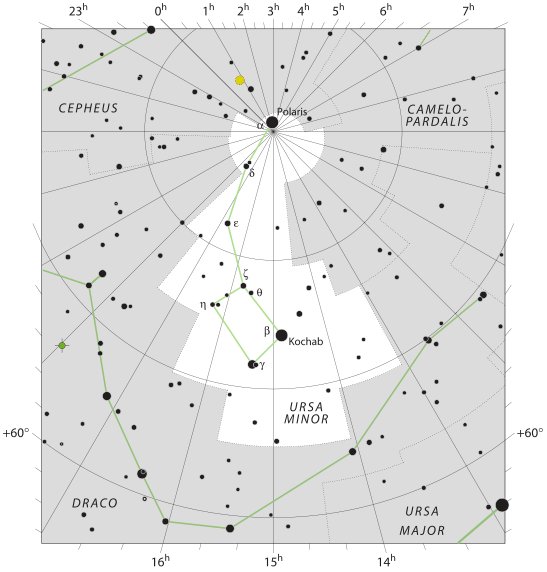
May 28, 3149 B.C. was (3149 +
1842) / 71 = ca 70 right ascension days
earlier than my assumed time for rongorongo.
And 70 + 16 = 86:
 |
 |
 |
 |
 |
|
Ga1-22 |
Ga1-23 → 403 - 280 |
Ga1-24 → 48 |
Ga1-25 → 5 * 5 * 5 |
Ga1-26 |
 |
|
μ Columbae,
SAIPH
(Sword) = κ Orionis
(86.5), τ Aurigae, ζ Leporis
(86.6) |
υ Aurigae (87.1), ν Aurigae
(87.2),
WEZN
(Weight) = β Columbae,
δ Leporis (87.7),
TZE (Son) = λ Columbae
(87.9) |
Ardra-6 (The Moist One) /
ANA-VARU-8 (Pillar to sit
by)
χ¹ Orionis, ξ Aurigae (88.1),
BETELGEUZE
= Α Orionis (88.3),
ξ Columbae (88.5), σ Columbae
(88.7)
ZUBEN ELGENUBI (α Librae)
|
η Leporis (89.0),
PRAJA-PĀTI
= Δ Aurigae, MENKALINAN = Β
Aurigae, MAHASHIM = Θ Aurigae,
and Γ Columbae (89.3),
π Aurigae (89.4), η Columbae
(89.7) |
μ
Orionis (90.3),
χ² Orionis (90.5) |
|
June 15 |
16 |
17 (168) |
18 |
19 |
|
°June 11 |
12 |
13 (164) |
14 |
15 (*86) |
|
'May 19 |
20 |
21 (141) |
22 |
23 (*63) |
|
"May 5 |
6 |
7 (127) |
8 |
9 (*49) |
|
APRIL 12 |
13 |
14 (104) |
15 |
16 (*26) |
|
82 |
83 |
84 (= 12 * 7) |
85 (= 5 * 17) |
86 |
 |
|
CLOSE TO THE FULL MOON
ON EASTER ISLAND: |
|
MULIPHEN = γ Ophiuchi
(269.0),
BASANISMUS = G Scorpii
(269.5),
PHERKARD
(The Dim One of the Two Calves)
= δ Ursae Minoris
(269.9) |
PTOLEMY CLUSTER = M7 Scorpii
(270.5),
GRUMIUM = ξ Draconis
(270.9) |
RUKBALGETHI GENUBI = θ Herculis
(271.1), ξ Herculis (271.5),
ETAMIN =γ Draconis,
ν Herculis (271.7), ν Ophiuchi
(271.8) |
Cat's Eye = NGC6543 Draconis
(272.2), ζ Serpentis (272.4), τ
Ophiuchi (272.9) |
Winnowing Basket-7 (Leopard)
18h (273.4)
NASH
= γ Sagittarii
(273.7), θ Arae (273.8) |
|
The star γ Ursae Minoris
(Pherkad) had been at the arrow
point 37 right ascension earlier
than δ (Pherkard - the Dim One)
and Kochab (β) had been there 37
+ 7 = 44 days earlier.
... at the
ancient time of Bharani the star
at the North Pole was not
Polaris but
β Ursae Minoris - Kochab
(as in Babylonian Kakkab
= Star).
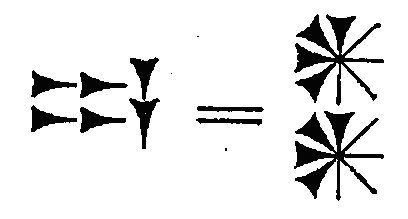
 |
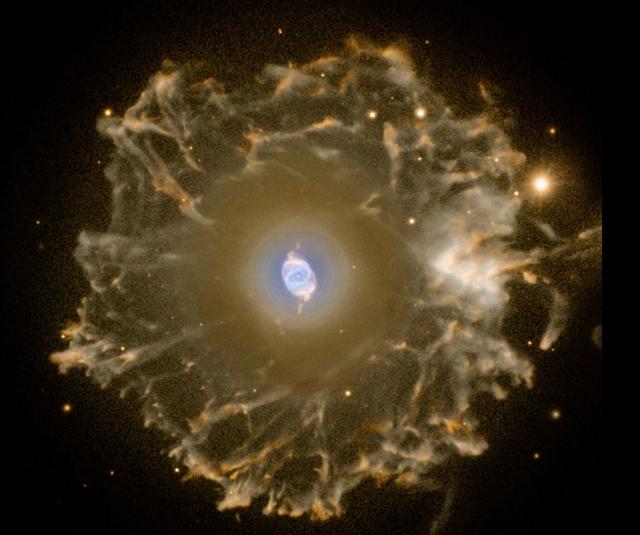 |

... Gronw Pebyr, who figures as
the lord of Penllyn - 'Lord of
the Lake' - which was also the
title of Tegid Voel, Cerridwen's
husband, is really Llew's twin
and tanist ... Gronw reigns
during the second half of the
year, after Llew's sacrificial
murder; and the weary stag whom
he kills and flays outside
Llew's castle stands for Llew
himself (a 'stag of seven
fights'). This constant shift in
symbolic values makes the
allegory difficult for the
prose-minded reader to follow,
but to the poet who remembers
the fate of the pastoral
Hercules the sense is
clear: after despatching Llew
with the dart hurled at him from
Bryn Kyvergyr, Gronw flays him,
cuts him to pieces and
distributes the pieces among his
merry-men. The clue is given in
the phrase 'baiting his dogs'.
Math had similarly made a stag
of his rival Gilvaethwy, earlier
in the story. It seems likely
that Llew's mediaeval successor,
Red Robin Hood, was also once
worshipped as a stag. His
presence at the Abbot's Bromley
Horn
Dance would be difficult to
account for otherwise, and
stag's horn moss is sometimes
called Robin Hood's Hatband. In
May, the stag puts on his red
summer coat. Llew visits the
Castle of Arianrhod in a coracle
of weed and sedge. The coracle
is the same old harvest basket
in which nearly every antique
Sun-god makes his New Year
voyage; and the virgin princess,
his mother, is always waiting to
greet him on the bank.
As has already been mentioned,
the Delphians worshipped
Dionysus once a year as the
new-born child, Liknites,
'the Child in the Harvest
Basket', which was a
shovel-shaped basket of rush and
osier used as a harvest basket,
a cradle, a manger, and a
winnowing-fan for tossing the
grain up into the air against
the wind, to separate it from
the chaff.
The worship of the Divine Child
was established in Minoan Crete,
its most famous early home in
Europe. In 1903, on the site of
the temple of Dictaean Zeues -
the Zeus who was yearly born in
Rhea's cave at Dicte near
Cnossos, where Pythagoras spent
'thrice nine hallowed days' of
his initiation - was found a
Greek hymn which seems to
preserve the original Minoan
formula in which the
gypsum-powdered, sword-dancing
Curetes, or tutors, saluted the
Child at his birthday feast. In
it he is hailed as 'the Cronian
one' who comes yearly to Dicte
mounted on a sow and escorted by
a spirit-throng, and begged for
peace and plenty as a reward for
their joyful leaps.
The tradition preserved by
Hyginus in his Poetic
Astronomy that the
constellation Capricorn
('He-goat') was Zeus's
foster-brother Aegipan, the Kid
of the Goat Amalthea whose horn
Zeus also placed among the
stars, shows that Zeus was born
at mid-winter when the Sun
entered the house of Capricorn.
The date is confirmed by the
alternative version of the myth,
that he was suckled by a sow -
evidently the one on whose back
he yearly rode into Dicte -
since in Egypt swine's flesh and
milk were
permitted
food only at the mid-winter
festival.
That the Sun-gods Dionysus,
Apollo and Mithras were all also
reputedly born at the Winter
solstice is well known, and the
Christian Church first fixed the
Nativity feast of Jesus Christ
at the same season, in the year
A.D. 273. St. Chrysostom,
a century later, said that the
intention was that 'while the
heathen were busied with their
profane rites the Christians
might perform their holy ones
without disturbance', but
justified the date as suitable
for one who was 'the Sun of
Righteousness'.
Another confirmation of the date
is that Zeus was the son of
Cronos, whom we have securely
identified with Fearn, or Bran,
the god of the F month in the
Beth-Luis-Nion. If one reckons
back 280 days from the Winter
Solstice, that is to say ten
months of the Beth-Luis-Nion
calendar, the normal period of
human gestation, one comes to
the first day of Fearn.
(Similarly, reckoning 280 days
forward from the Winter
Solstice, one comes to the first
day of the G month, Gore,
sacred to Dionysus; Dionysus the
vine and ivy-god, as opposed to
the Sun-god, was son to Zeus.)
Cuchulain was born as the result
of his mother's swallowing a
may-fly; but in Ireland
may-flies often appear in late
March, so his birthday was
probably the same ... |
|
Dec 15 |
16 (350) |
17 |
18 |
19 |
|
°Dec 11 |
12 |
13 |
14 |
15 |
|
OCT 12 (285) |
13 |
14 |
15 |
16 |
|
265 |
266 |
267 |
268 |
269 |
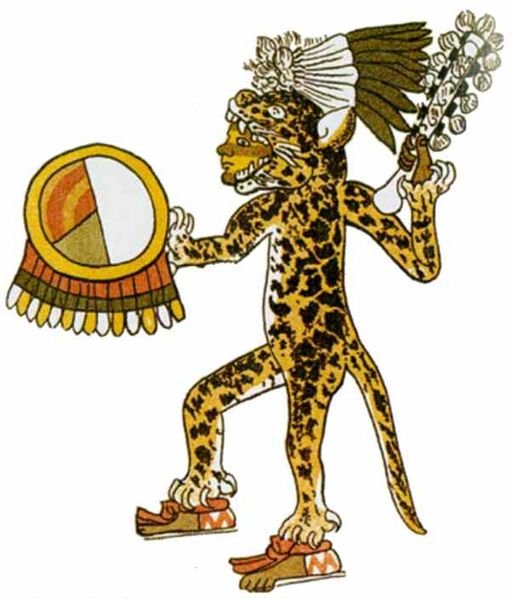
|
